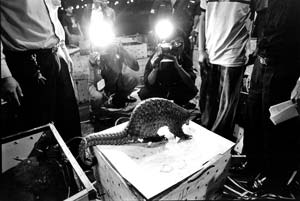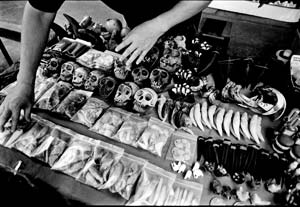Poaching Pictures
Air Date: Week of August 5, 2005

In the Thai/Burmese border towns of Moung La and Tachilek, markets display everything from rhino horns to macaque skulls for tourists. (Photo: © Patrick Brown/Panos)
Patrick Brown tracks the illegal wildlife trade in Asia—with a camera. His black and white photos tell the story of the business of trafficking animals--from the small-time poacher to the tables at the marketplace to international airports and Scotland Yard whose staff of four is charged with curbing wildlife smuggling. Brown tells Living on Earth’s Jeff Young that he hopes to use his work to educate some of the people involved in the business.
Transcript
YOUNG: Flip through the current issue of Mother Jones magazine and you’ll come across some startling black and white images of rare Asian animals. You’ll also see images of some of the people making these animals even more rare—poachers and dealers in the illegal trade in wildlife. Photographer Patrick Brown trekked through southern Asia to take those pictures and he’s with us now to talk about them. Mr. Brown, welcome to Living on Earth.

Thai officials seize a live pangolin at Bangkok International Airport. (Photo: © Patrick Brown/Panos)
BROWN: Thank you very much for having me.
YOUNG: You’ve been following the illegal animal trade for almost three years now. What is it about this that holds your interest as a photographer?
BROWN: Well, I focused not so much on the animals themselves, but I photographed more on the social implications of this trade and I wanted to try and feel and get the information across to the viewer of what it’s like to be these hunters, be those poachers, actually switch the roles around because these guys don’t really know what they’re doing so I’m trying to show the viewer a story of what’s actually happening on the cold face so to speak.
YOUNG: It does have a very documentarian feel to it, like you said these aren’t beauty shots of wild animals. One here that kind of jumps out at me, it’s a stall in what looks like an open-air market and the table there is covered with skulls and different animal parts for sale, where is that photo, and what’s going on there?
BROWN: That’s on the northern border of Thailand and Burma, an area that’s quite infamous and that’s the Golden Triangle. What that person’s just selling bits and pieces basically. Just trying to make a few bucks to buy some food, to pay rent, do all the things that we all do.
YOUNG: What sort of things would be on sale there? What would you pick up there? Not that you would.
BROWN: You could pick up anything. I found a rhino, a complete rhino horn which is extremely rare to find a complete one and they wanted eight and a half thousand U.S. which sounds a lot, but if I was a dealer by the time I got that to Hong Kong or the Middle East or Singapore or something like that it would be a hundred and twenty, a hundred and thirty thousand U.S. So it’s serious money at stake.
|
YOUNG: How do you get access to take these pictures? How to get to where you need to be to take these shots? BROWN: When I first got involved in this project, I thought, okay, it’s a very subdued subject, it’s a dark element of society, how am I going to get into this? So I went to places like the Thai-Burma border and I would pull out my camera and I would secretly try and take pictures and they were on to me straight away, they knew exactly what I was doing. It wasn’t the camera I finally figured out, it was my body language. I knew that I was doing something that they didn’t want me to know that I was doing and I just kept getting nowhere with it. Absolutely just banging my head against a brick wall so to speak. YOUNG: So what’s the correct body language? How do you communicate that they can relax? You just act like you’re taking a snapshot of the picnic or something or what? BROWN: Basically. I went in there with, I thought, how can I disarm these people? I thought, hang on, what I’ll do is I’ll show them all my tools. I’ll show them who I am, I’ll show them my camera and I won’t deny the fact that I’m taking pictures. And I went in there with, and I sort of all guns blazing lights flashing, quite a loud T-shirt. I dressed quite touristy-like and an old camera around my neck and that was it, they were disarmed. And I would say, wow, really we don’t have this in Australia. We don’t have bears like this and wow, you’ve got bears’ paws and then the guy would say, well you think that’s really weird, you should see what’s in the back of the shop. And that’s how I got into the back of these places. YOUNG: You know another image that really stands out in this spread in the magazine, it’s what I would call a perfectly normal looking office except there’s a severed tiger’s head on the top of the desk and I take it this is an office in Scotland Yard of some officer who’s in the effort to intercept these type of smuggled goods as they’re making their way around the world. How good a job do you think we’re doing at that? BROWN: As good a job as we’re doing in the drug trade. (laughter) YOUNG: Which I’m guessing is to say, not so good. BROWN: Not so good at all. With the political climate at the moment, customs and the authorities are looking for arms at the moment. Then it goes down to people, then people contraband, and then from there it’s animals. Animals are at the bottom of the rung. The developed world does not consider them a serious threat because they’re not actually, it’s not part of their constituency so we, I say we, I say as a developed society, we don’t take it seriously but meanwhile we tell developing nations to take it seriously. YOUNG: Well, do you intend to stick with this? I mean if part of your goal here is to use your photography as a form of public education, doesn’t exactly sound like you’re hopeful.  In the Thai/Burmese border towns of Moung La and Tachilek, markets display everything from rhino horns to macaque skulls for tourists. (Photo: © Patrick Brown/Panos) |
BROWN: I’m an optimist at the end of the day. I’ll cut to the chase, I am going to stick with this, I think it’s going to turn into a large portion of my work for my life actually. It’s actually going to be the animal trade in Asia. The other element to that is the people who are interested in my work are pretty much already the converted. They already know something about it. What my plan is is actually to take these images and take them to places like Burma, take them to Cambodia, to Laos, India, Nepal, actually take it to the places where the poachers are and get the stories translated into the local language or the local dialect. That is going to do more than somebody buying a book on a bookshelf in New York. YOUNG: Patrick Brown’s photo essay on the illegal trade in Asian wildlife appears in the July/August issue of Mother Jones magazine. Patrick thank you very much for joining us today. BROWN: Not a problem Jeff. Thank you very much. Links
|






